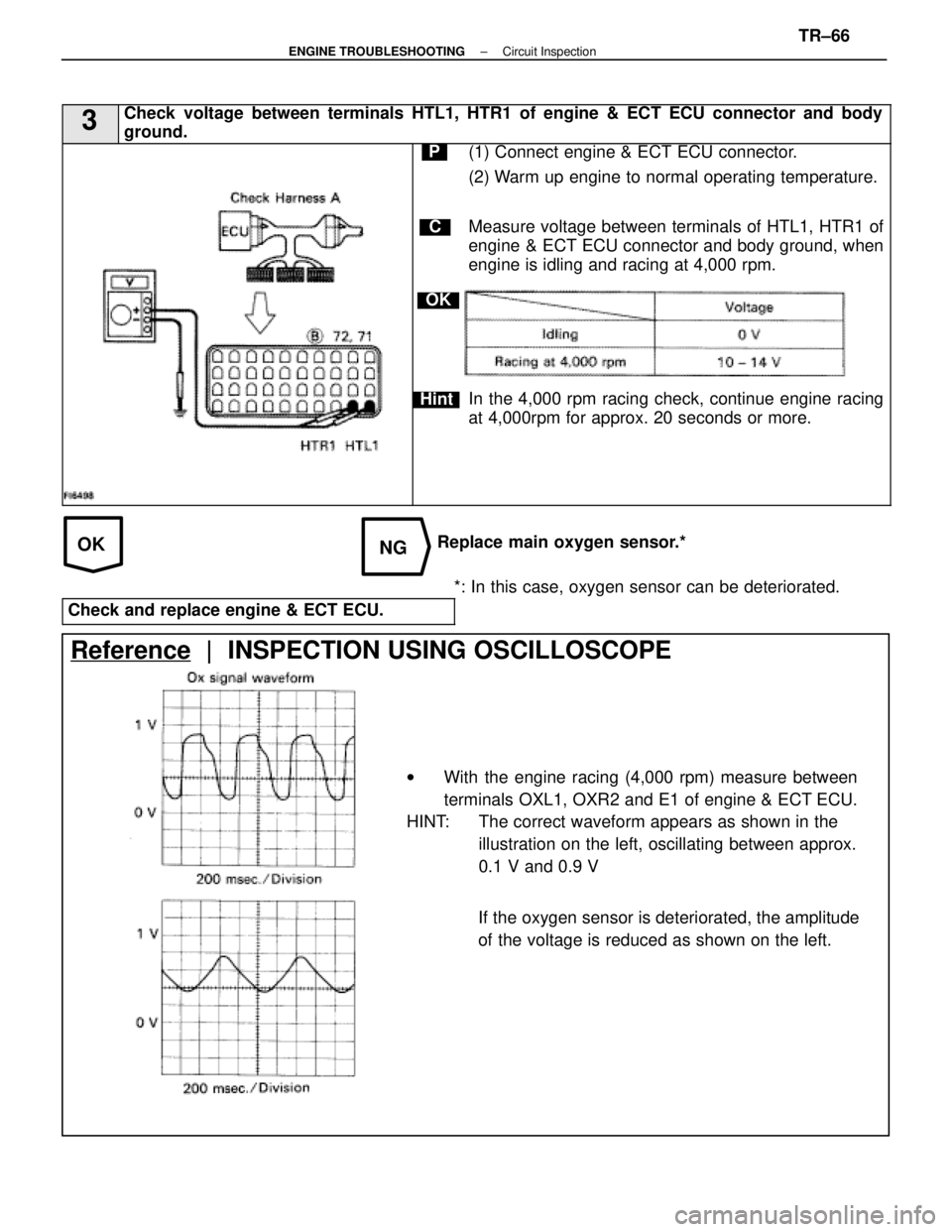Page 2675 of 4087
DIAGNOSTIC CHART
DIAGNOSTIC
CHART
WIRING DIAGRAM
HINT: If diag. code º21º is output, check the left bank main oxygen sens\
or circuit. If diag. code º28º is output, check the right bank main oxygen sensor circuit.
Check voltage of terminals HTL1, HTR1.
Check resistance of oxygen sensor heater.
Check and repair oxygen sensor heater circuit.
Check operation of oxygen sensor heater.
Check and replace ECU. Replace main oxygen sensor.
*: In this case, oxygen sensor can be deteriorated.
Replace main oxygen sensor.*
±
ENGINE TROUBLESHOOTING Circuit InspectionTR±64
WhereEverybodyKnowsYourName
Page 2676 of 4087
OKNG
OKNG
INSPECTION PROCEDURE
1Disconnect the engine & ECT ECU connector, check voltage between terminals HTL1, HTR1 of
engine & ECT ECU connector and body ground.
C
OK
P(2) Connect the Check Harness A.(See page TR±30)
(2) Disconnect engine & ECT ECU connector.
(2) Turn ignition switch on.
Measure voltage beween terminals HTL1, HTR1 of en-
gine & ECT ECU connector and body ground.
Voltage: 10 ± 14 V
Go to step [3].
2Check main oxygen sensor heater.
C
OK
PDisconnect main oxygen sensor connector.
Measure resistance between terminals 1 and 2 of main
oxygen sensor connector.
Resistance: 5.1 ± 6.3 � at 20 �C (68 �F)
Replace main oxygen sensor.
Check and repair harness or connector between
main relay and main oxygen sensor, main oxygen
sensor and engine & ECT ECU.
TR±65±
ENGINE TROUBLESHOOTING Circuit Inspection
WhereEverybodyKnowsYourName
Page 2677 of 4087

OKNG
3Check voltage between terminals HTL1, HTR1 of engine & ECT ECU connector and \
body
ground.
C
OK
Hint
P(1) Connect engine & ECT ECU connector.
(2) Warm up engine to normal operating temperature.
Measure voltage between terminals of HTL1, HTR1 of
engine & ECT ECU connector and body ground, when
engine is idling and racing at 4,000 rpm.
In the 4,000 rpm racing check, continue engine racing
at 4,000rpm for approx. 20 seconds or more.
Replace main oxygen sensor.**: In this case, oxygen sensor can be deteriorated.
Check and replace engine & ECT ECU.
Reference | INSPECTION USING OSCILLOSCOPE
w With the engine racing (4,000 rpm) measure between
terminals OXL1, OXR2 and E1 of engine & ECT ECU.
HINT: The correct waveform appears as shown in the
illustration on the left, oscillating between approx.
0.1 V and 0.9 V
If the oxygen sensor is deteriorated, the amplitude
of the voltage is reduced as shown on the left.
±
ENGINE TROUBLESHOOTING Circuit InspectionTR±66
WhereEverybodyKnowsYourName
Page 2685 of 4087

Diag Code
25Air±Fuel Ratio Lean Malfunction
Diag. Code
26Air±Fuel Ratio Rich Malfunction
CIRCUIT DESCRIPTION
Refer to page TR±62 for the circuit description.
Code No.Diagnostic Code Detecting ConditionTrouble Area
(1) Main oxygen sensor voltage is 0.45 V or less (lean)
for 90 sec. under conditions (a) and (b).
(2 trip detection logic)*
(a) Coolant temp.: 60 5C (140 5F) or more.
(b) Engine speed: 1,500 rpm or more.�Open or short in main oxygen sensor circuit
�Main oxygen sensor
�Ignition system
�Water temp. sensor
25 V
26
(2) Main oxygen sensor voltage is alternating above and below 0.45 V at 5 times par
second or more under conditions (a) and (b).
(2 trip detection logic)*
(a) Engine speed: Idling
(b) Coolant temp.: Between 60 5C (140 5F)
and 95 5C (203 5F)
�Open or short in injector circuit.
�Fuel line pressure (injector blockage)
�Air flow meter (air intake)
�Engine ground bolt loose
�Foreign object caught in valve
(3) Difference of air±fuel ratio feedback compensation
value between right and left banks is more than 10
percentage for 30 sec. or more under conditions (a)
and (b).
(2 trip detection logic)*
(a) Engine speed : 2,000 rpm or more.
(b) Coolant temp.: Between 60 5C (140 5F)
and 95 5C (203 5F)
�Fuel line pressure (injector leak, blockage)
�Mechanical system malfunction
(skipping teeth of timing belt)
�Ignition system
*: See page TR±21.
±
ENGINE TROUBLESHOOTING Circuit InspectionTR±74
WhereEverybodyKnowsYourName
Page 2686 of 4087
CIRCUIT DESCRIPTION (Cont'd)
DIAGNOSIS CODE DETECTION DRIVING PATTERN
Purpose of the driving pattern.
(a) To simulate diag. code detecting condition after diag. code is recorded.
(b) To check that the malfunction is corrected when the repair is completed c\
onfirming that diag. code is no longer detected.
Malfunction: Open or Short in Main Oxygen Sensor
�Initiate test mode (See page TR±12).
�Start engine and warm up.
�After engine is warmed up, let it idle for 3 min.
�Perform quick racing to 4,000 rpm three times by accelerator pedal.
�After performing the racing in (4), perform racing at 2,000 rpm for 90\
sec.
HINT: If a malfunction exists, the ºCHECKº engine warning light will light up after 90 sec. from the start of racing.
NOTICE: If the conditions in this test are not strictly followed, detection of t\
he malfunction will not be possible.
TR±75±
ENGINE TROUBLESHOOTING Circuit Inspection
WhereEverybodyKnowsYourName
Page 2688 of 4087
DIAGNOSTIC CHART
DIAGNOSTIC
CHART
WIRING DIAGRAM
Refer to page TR±64 for the WIRING DIAGRAM.
Check and replace ECU. Repair or replace harness or
connector.
Check compression Check and replace ECU.
Does malfunction disappear when a good main
oxygen sensor is installed?
Check compression.
Check each item found to be a possible cause
of problem. Check for open and short in harness and
connector.
Check voltage of terminal OX.
Check voltage of terminal VF.
Replace main oxygen sensor. Repair or replace.
Does malfunction disappear when a good main
oxygen sensor is installed? Check each item found to be a possible cause
of problem. Replace main oxygen sensor.
Repair or replace.
Repair or replace.
Repair or replace.
TR±77±
ENGINE TROUBLESHOOTING Circuit Inspection
WhereEverybodyKnowsYourName
Page 2689 of 4087
NG
Type ING
Type II
NG
OK
INSPECTION PROCEDURE
1Check voltage between terminals VF1, VF2 and E1 of check connector.
C
P(2) Warm up engine at normal operating temperature.
(2) Connect terminals TE1 and E1 of check connector.
(2) Connect positive prove to terminal VF1, VF2 and negative prove to terminal E1 of check connector.
(2) Warm up the oxygen sensor by running engine at 2,500 rpm for about 2 minutes.
(2) Then, maintaining engine at 2,500 rpm, count how many times needle of voltmeter fluctuates between
0 and 5 V
Result:
Go to step [7].
2Check voltage beween terminals OX1, OX2 and E1 of check connector.
C
OK
Hint
PWarm up engine at normal operating temperature.
Measure voltage between terminals OX1, OX2 and E1
of check connector when sngine is suddenly raced to full
throttle.
The Voltage should be 0.5 V or higher at least once.
Perform inspection within 1 second
Go to step [7].
±
ENGINE TROUBLESHOOTING Circuit InspectionTR±78
WhereEverybodyKnowsYourName
Page 2690 of 4087
OKNG
OKNG
OKNG
NOYES
3
Check for open and short in harness and connector between engine & ECT ECU an\
d main oxy-
gen sensor, engine & ECT ECU and check connector (See page IN±27).
Repair or replace harness or connector.
4Check each item found to be a possible cause of problem.
Check each circuit found to be a possible cause of trouble according to the results of the check in \
1 or
2 . The numbers in the table below show the order in which the checks sho\
uld be preformed.
TR±132
TR±6
TR±51
TR±13
TR±114
TR±88
TR±68
TR±72
Repair or replace.
5Check comparession (See page EM±30).
Repair or replace.
6Does malfunction disappear when a good main oxygen sensor is installed?
Replace main oxygen sensor.
check and replace engine & ECT ECU.
TR±79±
ENGINE TROUBLESHOOTING Circuit Inspection
WhereEverybodyKnowsYourName